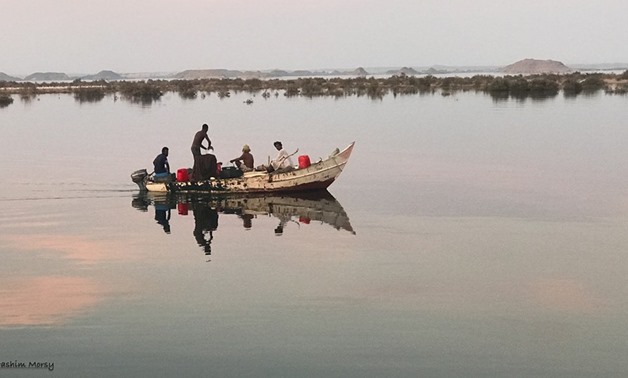
Photo of Fishing in Nasser Lake behind the High Dam, Old Nubia, Aswan, Egypt - Hashim Morsy Facebook page on 23 November 2017
CAIRO - 27 November 2017: Years ago, Gamal Abdel Nasser; Egyptian former leader, instructed to build Egypt’s biggest national project: the High Dam. Do displaced Nubian migrants deem the dam as great or it is true that every pro has a con?
The High Dam was built under the name of Aswan Dam. It was mainly meant to generate power and regulate the seasonal flooding of the Nile. Being one of the former leader’s greatest achievements, for the Egyptians, especially the farmers, the dam was the dream that came true as they have suffered for years from the loss of their crops due to the seasonal unexpected floods.
 Photo of Ramses II Temple, Old Nubia, Aswan, Egypt, Hashim Morsy facebook page, 24 November 2017
Photo of Ramses II Temple, Old Nubia, Aswan, Egypt, Hashim Morsy facebook page, 24 November 2017
The establishment of the Dam started with Aswan Dam/reservoir in 1902. The increasing rate of water flow behind the dam flooded 44 Nubian villages and displaced 18000 Nubian families in the aftermath. The area is known now as “old Nubia.”
Nostalgic were the Nubians who deserted their houses and saw them sink beneath the rising water, they had to migrate to Kom Ambo area known as “New Nubia.” The biggest migration took place when the construction of the High Dam occurred in 1963. Nubians witnessed a shift in the way of life around the Nile view to a new desert life in villages built for them in Kom Ambo.
 photo of a corridor with pharonic inscriptions in Amada Temple, Old Nubia, Aswan, Egypt, Hashim Morsy facebook page, 23 November 2017
photo of a corridor with pharonic inscriptions in Amada Temple, Old Nubia, Aswan, Egypt, Hashim Morsy facebook page, 23 November 2017
As sad as the story might sound, the full half of the cup is that the old Nubian Area is full of picturesque remains and main attractions made the place as a main destination for tourists worldwide.
Amada Temple, the oldest Egyptian temple in old Nubia built in the eighteenth century and located 180 KM behind High Dam. Though small and abandoned, Amada contains some important inscriptions. For instance, some inscriptions on one of the temple’s columns describes Amenhotep II leading an Egyptian military campaign into Asia, and bringing back the bodies of rebel chieftains to hang on the walls of Thebes. On another column a story describes his ship sailing through Nubia as a warning for his rivals.
 Photo of Amada Temple, Old Nubia Aswan, Egypt,Hashim Morsy facebook page, 23 November 2017
Photo of Amada Temple, Old Nubia Aswan, Egypt,Hashim Morsy facebook page, 23 November 2017
Qasr Ibrim is an archeological site in old Nubia. It was originally a major city perched on a cliff above the Nile, but the flooding of Nasser's Lake after the construction of Aswan High Dam transformed it into an island and flooded its outskirts. Ibrim stands as the only major archaeological site in old Nubia to have survived the Nile floods.
 Photo of Nasser Lake behind the High Dam, Aswan, Egypt, Hashim Morsy facebook page, 23 November 2017
Photo of Nasser Lake behind the High Dam, Aswan, Egypt, Hashim Morsy facebook page, 23 November 2017
Ramses II Temple in Abu Simbel is one of Egypt’s most famous archeological sites and a top attraction for visitors despite its far distance from Cairo. The temple was designed in the 13th Century BC to strike awe into travelers, introducing them to the grandeur of Egyptian culture. The four largest statues in front are Ramses II, and the smaller ones next to them are fashioned to resemble his favorite wife, Nefertari and Prince Amonherkhepshef, his son. Egyptian engineers moved the temple block by block to save it from the rising waters of Nasser Lake in the late 1960.





Comments
Leave a Comment